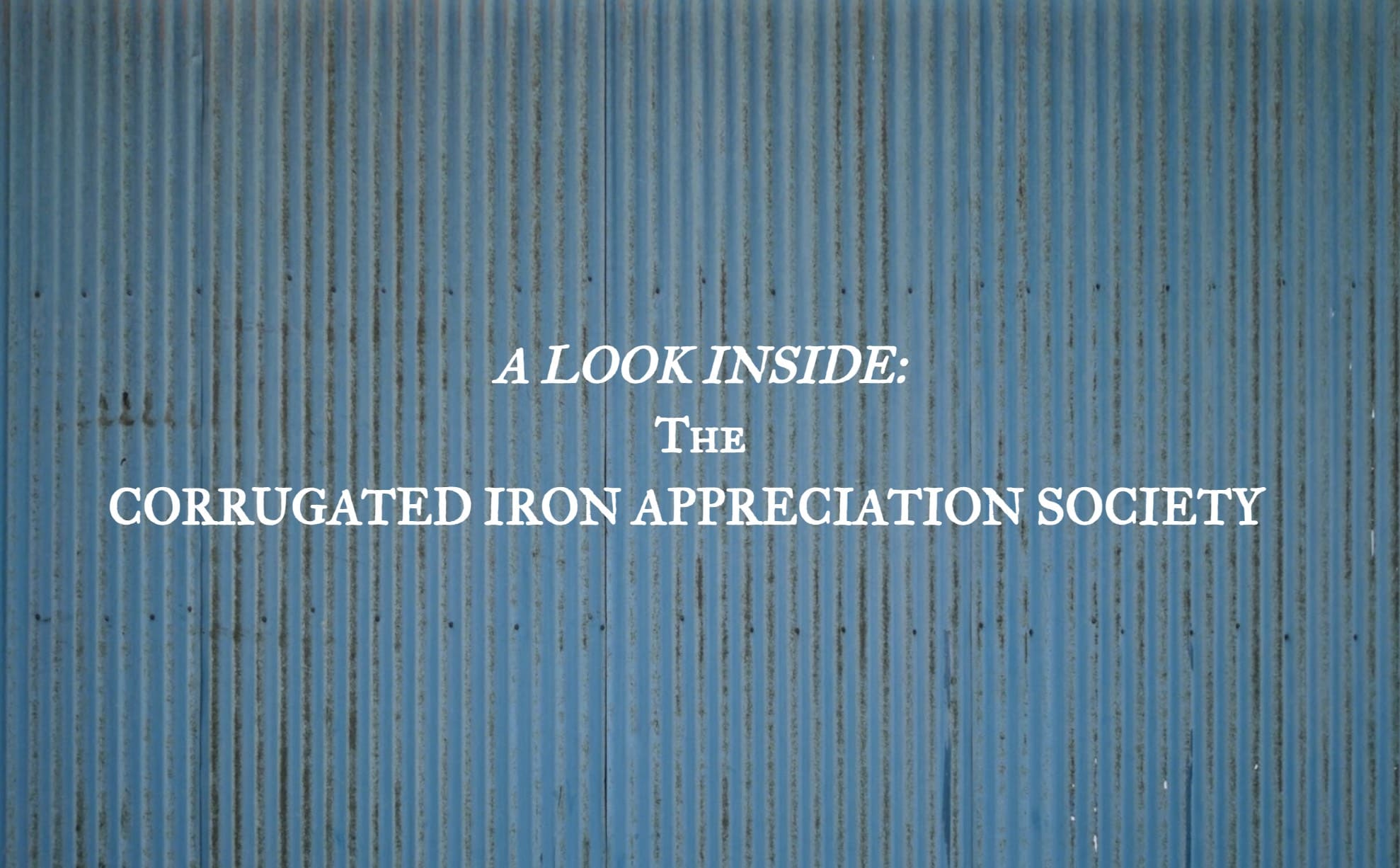
It is a truth universally acknowledged that in the depths of the internet exist assemblages of people ready and willing to obsess over anything. In this article, we take a look at the steadily growing members group who discuss in countless daily posts the beauty and importance of Corrugated Iron, or CI, for short.

Corrugated iron covers the entrance to Wentworth buildings in Goulston Street, East London, 1985.
As I discover from speaking to the Thane of this society, this particular building material seems to have struck an emotional chord with its now more than ten thousand members.
Invented in the 1820s in Britain by a certain Henry Robinson Palmer, the original CI was made from wrought iron, and proved to be light, strong, corrosion-resistant, and easily transported – lending itself particularly to prefabricated structures.
…it forces you to remember the beauty in simplicity all around us.
It became a common construction material in rural areas around the world, and in Australia and New Zealand particularly it has become part of the cultural identity. It is widely used as a building material in African slums and informal settlements, spawning such things as tin tabernacles – more commonly known as iron churches. It is one of those rare materials that holds equal importance to people who have seen its use in war or poverty, and people who have merely used it as part of home improvement, farm protection, or simply as remnants in a post-industrial landscape.
Its use is so ubiquitous that we barely notice its presence, so when stumbling across a sect so dedicated to it, it forces you to remember the beauty in simplicity all around us.

This patched-up roadside barn is appealingly rustic and lop-sided.

A passenger rail carriage sold off by the railways, probably around the 1960s as a result of the Beeching Plans, and used a shed in a farmer’s field.
A cursory glance at the group reveals that it is primarily UK-centric, but due to the widespread colonisation of place names around the English-speaking world, a lot of the images posted by the various contributors are actually from around the world. In speaking to Ivan Pope, founder of the Corrugated Iron Appreciation Society, one understands that the draw is from it being “a totally utilitarian product that is considered disposable.”
Pope, who is a writer and artist with particular interest in Brutalism explains that he is “as astounded as anyone by the success of the group. Although I see CI as just another part of the rich tapestry of industrial materials in the landscape … [m]aybe … people instinctively like CI as a material but have never seen this articulated. I love how many people express how they always thought they were alone in loving CI!”
Corrugated iron became of particular use in Britain during the Second World War, when hundreds of thousands of tons of it were produced to build Anderson shelters in gardens and alleys. It was equally used in the immediately recognisable Nissen huts of WW2, which served as barracks for British military and were adapted by the USA into Quonset huts.
The Nissen hut could be packed in a standard Army wagon and erected by six men in four hours. The world record for erection was one hour and 27 minutes.
A lot of the corrugated iron in Britain is painted a specific shade of green, demonstrably because a lot of it was government surplus shades or ex-government properties. The CI was also never far from politics, appearing in squats over history, for example in this empty house in Paddington with Piers Corbyn, elder brother of Jeremy.
There was also its wide use in ‘Frestonia’, the name adopted by the residents of Freston Road, London, when they attempted to secede from the United Kingdom in 1977.

A group of ‘squatters’ occupying an empty house at 19 Elgin Avenue, Paddington, London, UK, 1974.

British actor David Rappaport poses as Foreign Minister for Frestonia. (Photo: Aubrey Hart)

A woman sweeps her backyard amidst sheets corrugated iron which are shortly to be assembled into an air raid shelter, 1939. (Photo: London Express)
It’s interesting that as someone with such a specific background in Brutalist architecture Ivan Pope finds corrugated iron so specifically appealing. As he explains, Brutalism is all about removing the skin of the building: revealing the skeleton – the guts – of the building. Corrugated iron is the skin that so many have used to facade the outside of buildings.
On the other hand, Pope elaborates that the corrugated iron probably has more in common with Brutalist materials than immediately evident. “To me there is an inherent beauty in industrial structures”, he brings up the work of German conceptual artists Bernd and Hilla Becher, “and industrial materials.” He also runs a group named ‘Concrete Beauty’, established to pull away from the arguments about what counts and doesn’t count as ‘Brutalism’.
And as for whether there is a future for Brutalism? “I think there is … insofar as Brutalism is construction with total honesty to materials without any attempt to hide an internal framework or to decorate or make the building fancy. I would suggest that there could be a Brutalist corrugated iron building, [there] probably already is.”
The raison d’être for the group, Pope believes, is that “combinations of things [are] interesting.” Combinations of the industrial and foliage together, combinations of the rust with the natural, combinations of the straight lines with the abstract.

Corrugated iron covers concentrate the sun’s heat to dry the Cinchona bark harvested in the Dutch East Indies. When dry, the bark is pulverised to give quinine, used in the prevention and treatment of Malaria.

The statue of King Charles I in Whitehall is covered with protective sandbags, and packaged in corrugated iron, to protect it from bomb damage, 1939.
Pope also runs similarly peculiar – albeit much smaller – societies, including the Crane Appreciation Society and the Motorway Bridge Appreciation Society. “A while back I noticed that my cousin Cliff (now co-admin) was posting various pictures of corrugated iron buildings so I thought I’d start a group and see who else wanted to post. That’s about it – I didn’t expect it to grow so fast or to be so fascinating.”
It’s possible the people within the group are aware of the nicheness and potential for labelling as anoraks. Indeed, I felt that way when lurking around the group for several months, wondering why exactly I appreciated the contributions so much. But I think that Pope sums it up best when he spoke about the combinations. It is less the ridged material of the wriggly tin that is the draw, and more what that very same material draws out in its surroundings.
It is at once jarring and fully at home everywhere it is placed: an inviting presence from the outback of Australia to the sheds of London. Just like the Society, which I urge you to join.





2 Comments
Great idea !
I’m a lover of Romney Sheds! This is just great!